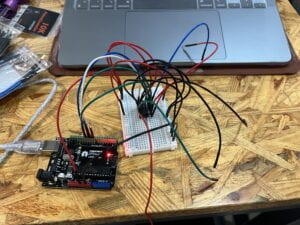Part One: Building Process
During the recitation, my partner and I first cut the cardboard according to the instruction.

Then, we set about building the circuit. However, due to the complexity of the wiring, we spent several minutes organizing the wires and figuring out how it works. The good news is we succeeded at the first attempt.


After that, in step 2, we use a hot glue gun, a shaft adaptor and some rivets to assemble the device. We came up with an idea that users can give a “little flower” to whoever stand in front of the device. Therefore, we personalized our device by drawing the pattern with markers.

When everything was ready and we started to run the code, the motor seemed powerless and didn’t work well.
We inspected the circuit, and found that two wires were loose. After some adjustment, the device worked better but was still not powerful enough to support the full rotation. Sadly, we didn’t have enough time to conduct further inspection then, but I supposed there must be something wrong with the connection of the motor or the motor itself.
The video of the ultimate effect (run manually) is posted below.
Part Two: Additional Questions
Question 1:
Matt Heckert, Centripetal Sound Machines, 2004
The art installation consists six striker sculptures (Wilson, 2013). Six rotary mechanical strikers sound specially designed resonators. Each striker sculpture has a motor that periodically lifts the circular metal track up and down. As the ring moves up and down, the central pipe strikers, which are attached to pivots, fall along the metal ring, thus creating the sounds. From my perspective, the machine is quite intriguing since it utilizes audio-visual effects to make the users feel like being inside a system. Compared to the device I built during the recitation, the similarity lies in the use of motors and their periodical motions, while the difference lies in the scale, and the principle of the centripetal sound machines is way more complex.

Question 2:
In my midterm project , the mechanism I’d like to build is the simulation of the sun, which is supported by a stick connected to a stepper. Besides, when users activate a light sensor, the servo, as well as two LEDs, simultaneously starts to move.
Speaking of how I expect my users to embrace in a physical interaction with my project, I’ll utilize some cues to silently guide them, such as written words “pick up a torch” and “follow the specific signs”, creating an simulation of a cave-exploring experience.
In particular, the differences between how my motors work and using an animation on a digital screen lie in the physical experience. Since what we are planning to make is more like visual arts, the users’ view on layers of different heights and angles matters, including the motion of motors. Consequently, if our project is implemented as the animation on a digital screen, it may fall short of our expected effect and lead to worse users’ experience, since they cannot physically be engaged with our setting of “exploration of a cave”.

Reference:
Wilson, S., & Berton, G. (2010). Art + science. Thames & Hudson.